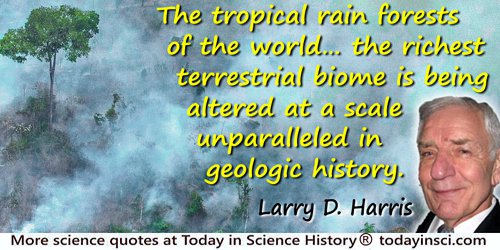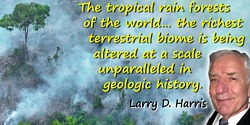 (source)
(source)
|
Larry D. Harris
(1942 - 15 Aug 2010)
American ecologist and author who was Professor Emeritus of Wildlife Ecology and Conservation at the University of Florida when he retired in 1999. After receiving his B.S. (1962), he joined the Peace Corps and served two tours in Tanzania, where he helped establish one of the country's first game parks at Mkomozi. The experience was followed by a lifelong commitment to wildlife conservation and landscape management for wildlife. He wrote The Fragmented Forest (1984).
|
Science Quotes by Larry D. Harris (6 quotes)
Now, rather than human development occurring in a matrix of natural landscape, natural areas occur in a matrix of human-dominated landscape.
[Co-author with J. Scheck]
[Co-author with J. Scheck]
— Larry D. Harris
As cited in Anthony B. Anderson and Clinton N. Jenkins, Applying Nature's Design: Corridors As A Strategy For Biodiversity Conservation (2006), 1.
Pursuit of the objective of maximum species diversity or even maximum species richness could lead to serious negative consequences if taken literally.
— Larry D. Harris
In The Fragmented Forest: Island Biogeography Theory and the Preservation of Biotic Diversity (1984), 106.
The maintenance of biological diversity requires special measures that extend far beyond the establishment of nature reserves. Several reasons for this stand out. Existing reserves have been selected according to a number of criteria, including the desire to protect nature, scenery, and watersheds, and to promote cultural values and recreational opportunities. The actual requirements of individual species, populations, and communities have seldom been known, nor has the available information always been employed in site selection and planning for nature reserves. The use of lands surrounding nature reserves has typically been inimical to conservation, since it has usually involved heavy use of pesticides, industrial development, and the presence of human settlements in which fire, hunting, and firewood gathering feature as elements of the local economy.
— Larry D. Harris
The Fragmented Forest: Island Biogeography Theory and the Preservation of Biotic Diversity (1984), xii.
The only level of the hierarchy [of biological communities] that is both necessary and sufficient to meet all objectives is the ecosystem or some higher-level approach. The strategy selected should not only ensure the conservation of spotted owls, but all the intricate linkages that are associated with natural populations of spotted owls in naturally functioning ecosystems. Many of these are as yet unknown.
— Larry D. Harris
In The Fragmented Forest: Island Biogeography Theory and the Preservation of Biotic Diversity (1984), 107.
The tropical rain forests of the world harbor the majority of the planet’s species, yet this wealth of species is being quickly spent. While the exact numbers of species involved and the rate of forest clearing are still under debate, the trend is unmistakable—the richest terrestrial biome is being altered at a scale unparalleled in geologic history.
— Larry D. Harris
In The Fragmented Forest: Island Biogeography Theory and the Preservation of Biotic Diversity (1984),
To the extent that remaining old-growth Douglas fir ecosystems possess unique structural and functional characteristics distinct from surrounding managed forests, the analogy between forest habitat islands and oceanic islands applies. Forest planning decision variables such as total acreage to be maintained, patch size frequency distribution, spatial distribution of patches, specific locations, and protective measures all need to be addressed.
— Larry D. Harris
In The Fragmented Forest: Island Biogeography Theory and the Preservation of Biotic Diversity (1984), 6.
See also:
- The Fragmented Forest: Island Biogeography Theory and the Preservation of Biotic Diversity, by Larry D. Harris. - book suggestion.


 In science it often happens that scientists say, 'You know that's a really good argument; my position is mistaken,' and then they would actually change their minds and you never hear that old view from them again. They really do it. It doesn't happen as often as it should, because scientists are human and change is sometimes painful. But it happens every day. I cannot recall the last time something like that happened in politics or religion.
(1987) --
In science it often happens that scientists say, 'You know that's a really good argument; my position is mistaken,' and then they would actually change their minds and you never hear that old view from them again. They really do it. It doesn't happen as often as it should, because scientists are human and change is sometimes painful. But it happens every day. I cannot recall the last time something like that happened in politics or religion.
(1987) -- 


